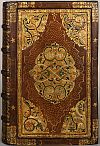 Ornate and luminous gilt covers and spines. Vibrant marbled covers that appear to be set in fast and perpetual motion. These beauteous aspects of ornamented rare books are what add to their uniqueness and value, as they ultimately grab the collector’s heart and interest before the rare book is even opened or read. It is a universal and uniting love for beauty and art that every individual on this earth possesses that draws us to these glorious rare books from their quiet perch atop a distant shelf. While the text within the rare book is undoubtedly enlightening, enjoyable, and inspiring to the fortunate beholder of the ornamented rare book, it is the mesmerizing and hypnotizing allure of the book’s exterior, which primarily captures the collector and causes the book to be opened for further examination.
Ornate and luminous gilt covers and spines. Vibrant marbled covers that appear to be set in fast and perpetual motion. These beauteous aspects of ornamented rare books are what add to their uniqueness and value, as they ultimately grab the collector’s heart and interest before the rare book is even opened or read. It is a universal and uniting love for beauty and art that every individual on this earth possesses that draws us to these glorious rare books from their quiet perch atop a distant shelf. While the text within the rare book is undoubtedly enlightening, enjoyable, and inspiring to the fortunate beholder of the ornamented rare book, it is the mesmerizing and hypnotizing allure of the book’s exterior, which primarily captures the collector and causes the book to be opened for further examination.
Ornamenting rare books is a practice which dates back to many centuries before us. Many famous authors published books which were originally ornamented, and which can still be found today. Jane Austen’s complete collection of novels is one such example, as well as the works of Edgar Allan Poe, Charles Dickens, and the Sisters Bronte, to name a short few. Perhaps it was the steadfast and devoted monks of the Middle Ages who tirelessly illuminated scrolls and parchments so that those who were literate could be immersed in both worlds of aesthetically pleasing images and uplifting written words who first gave us this brilliant notion.Whatever the origin of decorated rare books may be, it is vital to appreciate that these extraordinary objects do in fact exist, and that the rarest and most valuable of them are quite possibly within the collector’s grasp.
In the past, we have touched on the wondrous literary contributions which Jane Austen has put forth, but we have never before mentioned that many of Austen’s novels were intricately decorated and made exquisitely lovely through charming ornamentation on each novel’s cover and spine. The first edition of the novel Emma, for instance, bears elegant gilt scrolls and fluted gilt flowers on its spine, as well as gilt letter ‘A’s’ along the spine’s top. The transfixing cover of these particular copies of Emma, brazenly depict tones of orange, black, and yellow, in a composition which is almost reminiscent of a Jackson Pollack painting. Indeed, the exteriors of Ms. Austen’s novels may have closely coincided with her graceful yet determined and fiery nature, which she so clearly showed forth through her lively literary heroines in each of her delightful novels.
The works of Edgar Allan Poe, in particular, his volumes succinctly entitled, Tales and Poems, published by John C. Nimmo in 1884, display horizontal gilt ribbing along the volumes’ spines, as well as a chaotic and wondrous scene of flamboyant hues of red, blue, and tan marbling on the volumes’ cover, Like Austen, this wild show of color could have closely matched Poe’s love of the unseemly and unconventional, while the staid and uniform gilt ribbing along the book’s spine could hint at Poe’s dry and matter of fact seriousness in narrating his tumultuous tales, which is so characteristic of his much beloved work.
Observing in person one of these rare and beautiful books is an experience which is uplifting and invigorating to the senses, as heart and eye are drawn to and encapsulated in the sheer artistic perfection of each lovely cover and spine. Holding one of these rare ornamented books in hand is true joy, as the yearning for beauty and peace within us all is instantly stilled. Reading and absorbing the book’s written text and soothing and ameliorative exterior enticement sparks creativity, and reminds us that amidst a turbulent and tumultuous culture, there still exists beauty, loveliness, and light, in the form of rare and ornamented books.
{ 0 comments… add one now }